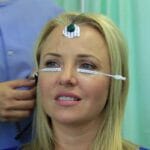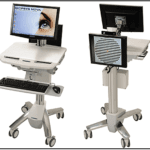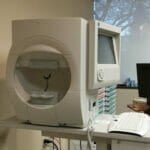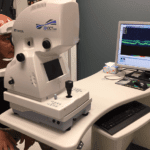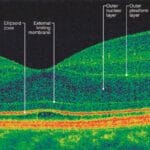Hydroxychloroquine - Eye Test
At the request of my Rheumatologist, I scheduled an appointment with my eye doctor for “high-risk medications testing”, since I’m taking Hydroxychloroquine. One of the nasty side effects of taking Hydroxychloroquine is that prolonged use can cause major vision issues. Overall, around seven patients out of every 100 taking hydroxychloroquine for more than five years may develop retinopathy that can be detected with specialized tests. Severe retinopathy, especially in the central area called the macula, causes significant, irreversible sight loss. My Rheumatologist wanted me to get a baseline test before I’m taking the medication for a prolonged time. So earlier this week, I saw my optometrist for testing.
The first test that they had me do was what is called a Visual Field Test. The test isn’t painful, but it certainly is annoying. I like it a kin to the hearing tests (audiometry) where you put on the headphones and click the button every time you hear the beep. That test always seems to be a guessing game after a while. Your mind plays games on your “did I just hear a beep?”, “Was that a beep”, “Damn, I clicked the button and there wasn’t a beep”. Well, the Visual Field Test is just like that, except you are looking for flashes of light. It lasts about 4-5 minutes per eye and is about as annoying as it can get, but overall, it isn’t painful in the least (unless you count having to sit in one spot for the length of the test, which is painful on its own.
The next test is the mERG (Multifocal electroretinogram), which is probably more annoying, but you aren’t required to sit still the entire time, like in the Visual Field Test. In this test, they put small electrodes on your forehead and under your eyes. They aren’t painful, just a little bit annoying, but the real fun starts when the test starts. You are sitting in front of a computer screen, staring at a red “X”, then the stimuli start. On the computer screen starts flashes of light in a pattern (sequenced hexagons), are designed to distinguish retinal visual loss from non-retinal visual loss. This test reminds me of a dance club, as the sequenced hexagons flash in unison to guitar techno-themed music, something right out of an Avicii remix. This test lasts about 60 seconds per cycle and it 4-5 cycles per eye.
The last test is the OCT (Optical Coherence Tomography) Macula test, which requires you to look into a machine for 30-40 seconds per eye. The OCT is a non-invasive imaging test. OCT uses light waves to take cross-section pictures of your retina.


